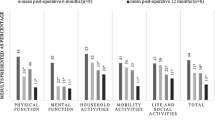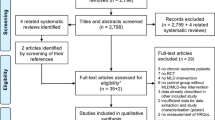Abstract
Background
Lymphedema is an adverse effect of breast cancer surgery. Aqua lymphatic therapy (ALT) is a novel treatment for limb volume reduction.
Objective
The aim of this study was to examine whether ALT is a safe method and whether there are differences in adherence, limb volume, and quality of life between women who perform only self-management treatment and women who participate as well in ALT.
Design
Design of the study was single-blind randomized clinical trial.
Setting
The setting was in a hydrotherapy pool, 1.2 m depth, and a temperature of 32–33°С.
Patients
Forty-eight women (56 ± 10 years), with a 12.8% lymphedema relative volume, participated in the study.
Intervention
The control group was instructed to perform the self-management treatment. The study group joined a weekly session of ALT for 3 months in addition to the self-management therapy.
Measurements
Adherence was assessed by a self-reported diary, limb volume by a water displacement device, quality of life by the Upper Limb Lymphedema Questionnaire (ULL27), prior to, and after the intervention period.
Results
There was no episode of arm infection or aggravation in limb volume during the study period. ALT had a positive, statistically and clinically significant immediate effect on limb volume but no long-term effect was noted. The adherence rate to ALT was significantly higher than the adherence to self-management therapy. QOL improved in the study group.
Conclusion
ALT was found to be a safe method, with high adherence, in treating women who suffer from mild to moderate lymphedema. A significant immediate and insignificant long-term effect on limb volume was noted.



Similar content being viewed by others
References
Erickson VS, Pearson ML, Ganz PA (2001) Arm edema in breast cancer patients. J Natl Cancer Inst 93:96–111. doi:10.1093/jnci/93.2.96
Petrek J, Pressman P (2000) Lymphedema: current issues in research and management. CA Cancer J Clin 50:292–307
Duff M, Hill AD, McGreal G (2001) Prospective evaluation of the morbidity of axillary clearance for breast cancer. Br J Surg 88:114–117. doi:10.1046/j.1365-2168.2001.01620.x
Lymphoedema Framework (2006) Best practice for the management of lymphoedema. International consensus. MEP, London
Golshan M, Smith B (2006) Prevention and management of arm lymphedema in the patient with breast cancer. J Support Oncol 4:381–386
Box RC, Reul-Hirche HM, Bullock-Saxton JE (2002) Shoulder movement after breast cancer surgery: results of a randomised controlled study of postoperative physiotherapy. Breast Cancer Res Treat 75:35–50. doi:10.1023/A:1016571204924
Meeske KA (2008) Risk factors for arm lymphedema following breast cancer diagnosis in black women and white women. Breast Cancer Res Treat 113:383–391
Soran A (2006) Breast cancer-related lymphedema—what are the significant predictors and how they affect the severity of lymphedema? Breast J 12:536–543. doi:10.1111/j.1524-4741.2006.00342.x
International Society of Lymphology (2003) The diagnosis and treatment of peripheral lymphedema. Consensus document of the International Society of Lymphology. Lymphology 36:84–91
Passik SD, McDonald MV (1998) Psychosocial aspects of upper extremity lymphedema in women treated for breast carcinoma. Cancer 83(Suppl):2817–2820. doi:10.1002/(SICI)1097-0142(19981215)83:12B+<2817::AID-CNCR32>3.0.CO;2-2
Casley-Smith JR, Casley Smith JR (1997) Modern treatment for lymphedema, 5th edn. The Lymphology Association of Australia, Adelaide Chapters 17, 21, 45
Moseley L, Carati CJ, Piller NB (2006) A systematic review of common conservative therapies for arm lymphoedema secondary to breast cancer treatment. Ann Oncol 18:639–646. doi:10.1093/annonc/mdl182
Vignes S, Porcher R (2007) Long-term management of breast cancer-related lymphedema after intensive decongestive physiotherapy. Breast Cancer Res Treat 101:285–290. doi:10.1007/s10549-006-9297-6
Boris M, Weindorf S, Lasinski B (1997) Persistence of lymphedema reduction after noninvasive complex lymphedema therapy. Oncology (Huntingt) 11:99–109; discussion 110, 113–114
Johansson K, Piller N (2007) Weight-bearing exercise and its impact on arm lymphedema. J Lymphoedema 2:15–18
Piller NB, Moseley AL, Carati CJ (2005) The effect of gentle arm exercise and deep breathing on secondary arm lymphedema. Lymphology 38:136–145
Ahmed RL, Thomas W, Yee D (2006) Randomized controlled trial of weight training and lymphedema in breast cancer survivors. J Clin Oncol 24:2765–2772. doi:10.1200/JCO.2005.03.6749
Harris SR, Niesen-Vertommen SL (2000) Challenging the myth of exercise-induced lymphedema following breast cancer: a series of case reports. J Surg Oncol 74:95–98. doi:10.1002/1096-9098(200006)74:2<95::AID-JSO3>3.0.CO;2-Q
Johansson K, Tibe K, Weibull A, Newton RC (2005) Low intensity resistance exercise for breast cancer patients with arm lymphedema with or without compression sleeve. Lymphology 38:167–180
Johansson K, Tibe K, Kanne L, Skantz H (2004) Controlled physical training for arm lymphedema patients. Lymphology 37(suppl):37–39
Tidhar D, Shimony A, Drouin J (2004) Aqua lymphatic therapy for postsurgical breast cancer lymphedema. Rehab Oncol 22:6–14
Boris M, Lasinski B (1994) Lymphedema reduction by noninvasive complex lymphedema therapy. Oncology 8:95–106
Boris M, Weindorf S, Lasinkski B (1997) Persistence of lymphedema reduction after noninvasive complex lymphedema therapy. Oncology 11:99–109
Lasinski B, Boris M (2002) Comprehensive lymphedema: management results of a 5 year follow-up. Lymphology 35(suppl):301–304
Megens AM, Harris SR (2001) Measurement of upper extremity volume in women after axillary dissection for breast cancer. Arch Phys Med Rehabil 82:1639–1644.
Karges JR, Mark BE, Stikeleather SJ, Worrell TW (2003) Concurrent validity of upper-extremity volume estimates: comparison of calculated volume derived from girth measurements and water displacement volume. Phys Ther 83:134–145
Launois R, Mègnigbêto AC, Pocquet K, Alliot F (2002) A specific quality of life scale in upper limb lymphedema : the ULL-27 questionnaire. Lymphology 35(Suppl):181–187
SPSS (1999) Statistical Program for the Social Sciences Version 9.0. SPSS, Chicago, IL
Bonnetblanc JM, Bédane C (2003) Erysipelas: recognition and management. Am J Clin Dermatol 4:157–163. doi:10.2165/00128071-200304030-00002
Papadopoulou C, Economou V (2008) Microbiological quality of indoor and outdoor swimming pools in Greece: investigation of the antibiotic resistance of the bacterial isolates. Int J Hyg Environ Health 211:385–397. doi:10.1016/j.ijheh.2007.06.007
Angenent LT, Kelley ST, St Amand A, Pace NR, Hernandez MT (2005) Molecular identification of potential pathogens in water and air of a hospital therapy pool. Proc Natl Acad Sci U S A 102:4860–4865. doi:10.1073/pnas.0501235102
McKenzie DC, Kalda AL (2003) Effect of upper extremity exercise on secondary lymphedema in breast cancer patients: a pilot study. J Clin Oncol 21:463–466. doi:10.1200/JCO.2003.04.069
Ko DS, Lerner R, Klose G, Cosimi AB (1998) Effective treatment of lymphedema of the extremities. Arch Surg 133:452–458. doi:10.1001/archsurg.133.4.452
Donovan JL, Blake DR (1992) Patient non-compliance: deviance or reasoned decision-making? Soc Sci Med 34:507–513. doi:10.1016/0277-9536(92)90206-6
Campbell R, Evans M, Tucker M, Quilty B, Dieppe P, Donovan JL (2001) Why don't patients do their exercises? Understanding non-compliance with physiotherapy in patients with osteoarthritis of the knee. J Epidemiol Community Health 55:132–138
Ramos SM, O'Donnell LS, Knight G (1999) Edema volume, not timing, is the key to success in lymphedema treatment. Am J Surg 178:311–315. doi:10.1016/S0002-9610(99)00185-3
Woo J, Chan W, Yeung F (2006) A community model of group therapy for the older patients with chronic obstructive pulmonary disease: a pilot study. J Eval Clin Pract 12:523–531. doi:10.1111/j.1365-2753.2006.00651.x
Sirois FM, Gick ML (2002) An investigation of the health beliefs and motivations of complementary medicine clients. Soc Sci Med 55:1025–1037. doi:10.1016/S0277-9536(01)00229-5
Floyer-Lea A, Matthews PM (2005) Distinguishable brain activation networks for short- and long-term motor skill learning. J Neurophysiol 94:512–518. doi:10.1152/jn.00717.2004
Mondry TE, Riffenburgh RH, Johnstone PA (2004) Prospective trial of complete decongestive therapy for upper extremity lymphedema after breast cancer therapy. Cancer J 10:42–48. doi:10.1097/00130404-200401000-00009
Penson RT, Partridge RA, Rudd P (2005) Laughter: the best medicine? Oncologist 10:651–660. doi:10.1634/theoncologist.10-8-651
Acknowledgments
We express our deepest gratitude to Prof. Judith R. Casley-Smith, for her support in the development of the aqua lymphatic therapy. We thank the physical therapists, Anat Assa and Ilana Shneiderman, for helping with the assessment measurements.
Author information
Authors and Affiliations
Corresponding author
Additional information
An erratum to this article can be found at http://dx.doi.org/10.1007/s00520-009-0695-2
Rights and permissions
About this article
Cite this article
Tidhar, D., Katz-Leurer, M. Aqua lymphatic therapy in women who suffer from breast cancer treatment-related lymphedema: a randomized controlled study. Support Care Cancer 18, 383–392 (2010). https://doi.org/10.1007/s00520-009-0669-4
Received:
Accepted:
Published:
Issue Date:
DOI: https://doi.org/10.1007/s00520-009-0669-4




